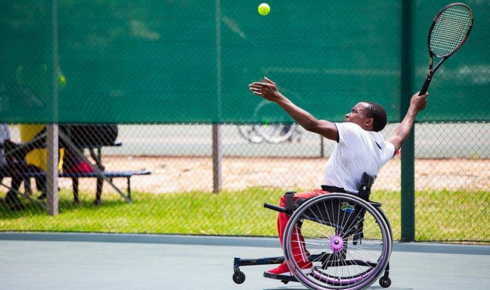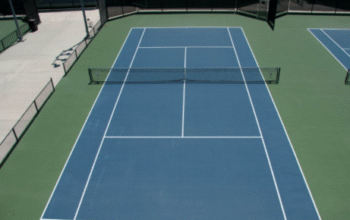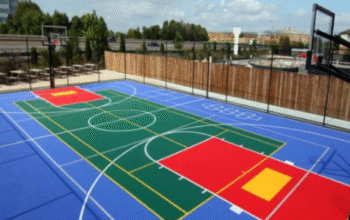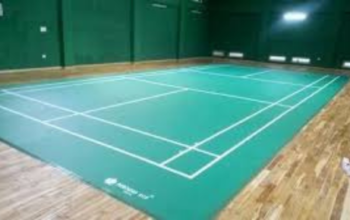If your tennis court is showing signs of wear—like cracks, fading colors, or inconsistent ball bounce—you might be considering a tennis court resurface. And with the rise of DIY tutorials and resurfacing kits available online, many court owners are wondering: “Should I do it myself or hire a professional?”
Resurfacing a tennis court isn’t just about applying fresh tennis court surface paint. It involves skill, tools, experience, and understanding of materials and application techniques. This blog compares DIY and professional resurfacing methods to help you make an informed decision.
The Growing Trend of DIY Resurfacing
With online guides and surface kits available for homeowners and sports facility managers, DIY tennis court resurfacing has gained popularity. It’s especially appealing for those looking to save costs and take control of their renovation timeline.
DIY kits include resurfacing materials like acrylic coatings, crack fillers, primers, and game line stencils. For minor touch-ups or temporary fixes, a DIY approach can work—but is it ideal for a complete resurfacing job? Let’s weigh both sides.
Pros of DIY Resurfacing
1. Cost Savings
The biggest reason most people opt for DIY is to save on labor costs. A resurfacing job done by professionals, while DIY kits can cost 40–60% less, depending on the materials used and the size of the court.
2. Flexibility
You can work on your own schedule without waiting for contractor availability. If you’re resurfacing a residential court or small recreational area, this can be a time-saving advantage.
3. Satisfaction of Personal Involvement
Many property owners take pride in handling maintenance themselves. The idea of personally upgrading your court may be rewarding and fulfilling.
Cons of DIY Resurfacing
1. Requires Specialized Tools
To resurface properly, you’ll need tools like squeegees, pressure washers, crack fillers, resurfacing machines, and court stripers. Buying or renting these can offset your initial savings.
2. Skill and Knowledge Gaps
Tennis court resurfacing involves technical steps—like base prep, proper mix ratios, curing times, and painting angles. Without experience, it’s easy to make costly mistakes.
3. Surface Uniformity Issues
Uneven application of tennis court surface paint can lead to streaks, poor traction, and uneven bounce—all of which affect playability.
4. Shorter Lifespan
A DIY surface job might look fine initially but may deteriorate faster due to incorrect preparation or inferior materials.
When You Should Hire a Professional
While a DIY approach might work for small repairs or low-traffic recreational courts, a professional resurfacing service is ideal when:
- The surface has deep cracks, root damage, or structural issues
- You want a warranty on materials and workmanship
- You’re resurfacing a public or commercial facility
- Safety standards and regulations need to be followed
- You require custom surface coatings or textures
Professional resurfacing teams use high-grade materials, advanced equipment, and adhere to global tennis standards—ensuring consistency in bounce, grip, and visual appeal.
Safety & Compliance with Standards
Whether the court is used for recreational or professional play, safety must be a priority. Improper resurfacing can lead to:
- Slippery or abrasive areas
- Uneven court levels
- Poor drainage and water pooling
- Inconsistent bounce affecting player performance
Certified installers follow industry standards for sports flooring, including ITF (International Tennis Federation) guidelines. They also understand how tennis court surface paint interacts with temperature, humidity, and surface texture—something most DIYers are unaware of.
Final Verdict: Choose Based on Long-Term Value
While DIY resurfacing may seem tempting due to lower upfront costs, it often results in higher maintenance, shorter court life, and less consistent play conditions. If you’re resurfacing a court that sees regular use or represents a serious investment—whether residential or commercial—it’s smarter to go with professionals.
Here’s a simple takeaway:
Go DIY for: Small residential courts with minor issues, temporary fixes, budget constraints
Go Pro for: Long-term performance, commercial use, professional gameplay, or damaged surfaces
Conclusion: Make the Right Investment
Your tennis court is more than a recreational space—it’s a long-term asset. Whether you choose the DIY route or hire a professional, the goal is to ensure that the tennis court resurface project enhances the safety, durability, and aesthetics of your facility.Professional installation ensures proper material use, consistent application of tennis court surface paint, and compliance with playability standards. Meanwhile, DIY resurfacing requires preparation, tools, time, and a clear understanding of what you’re getting into.




